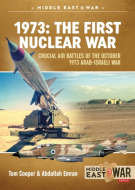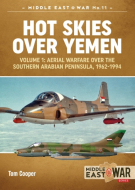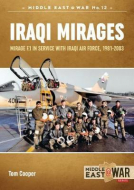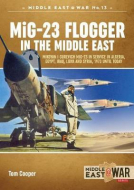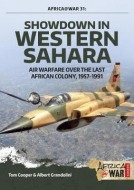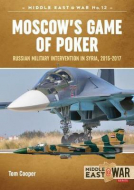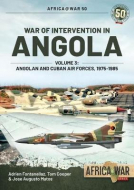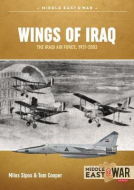
- Agriculture
- Architecture & Design
- Arts & Photography
- Biography
- Business
- Calendars and Diaries
- Childrens (All)
- Childrens (Illustrated)
- Childrens (Picture flats)
- Childrens (Te Reo)
- Classics
- Cooking, Food & Drink
- Craft & Hobbies
- Design (Art / Graphics)
- Design (Interiors)
- Education
- Fashion
- Fiction & Literature
- Fiction - Young Adult
- Gift Ideas
- Health & Wellbeing
- History
- Home & Garden
- Humour & Gift
- Instead of a Card Poems
- Military
- Music
- New Zealand
- NZ (History)
- NZ (Landscapes)
- NZ (Pictorial)
- Poetry
- Reference
- Religion & Faith
- Science & Nature
- Sport & Recreation
- Stationery
- Taschen : 40th Anniversary Edition
- Taschen : BA Basic Art
- Taschen : BU Bibliotheca Universalis
- Te Reo Māori
- Transport
- Travel
Tom Cooper (34)
|
Moscow's Game of Poker : Russian Military Intervention in Syria 2015-2017 (revised edition)
ISBN: 9781804510902 Author: Tom Cooper Publisher: Helion & Company In August 2015, the government of the Russian Federation embarked its military forces on an intervention in Syria. Ever since, there has been no end of discussi... In August 2015, the government of the Russian Federation embarked its military forces on an intervention in Syria. Ever since, there has been no end of discussion about Russian military capabilities and intentions – in Syria and beyond. To many, the performance of the Russian military – and especially the Russian Air-Space Force (VKS) – in this war was a clear demonstration of advanced technology, improved training, fearsome firepower, and great mobility. To others, the military operation only experienced limited success and exposed a number of weaknesses. Prominent amongst the latter were aircraft ill-suited to the necessities of expeditionary warfare, and a gross lack of advanced weaponry and equipment. While the military component of their intervention can only be described as having provided clear evidence that the Russian military was in no condition to directly challenge NATO’s eastern frontiers, it cannot be denied that through this action Moscow effected a turning point in the Syrian Civil War, and indeed one on a geostrategic level. Organised and conducted in cooperation with very diverse allies – ranging from the Islamic Revolutionary Guards Corps of Iran (IRGC), Hezbollah of Lebanon, the Kurdistan Workers Party (PKK) and a myriad of local warlords and their armed militias – through the combination of intentional bombardment of insurgent-controlled parts of Syria, and indirect protection for the IRGC’s own military intervention in the country from a possible counter-intervention of the West, the Russians succeeded in saving the regime of the Syrian President Bashar al-Assad. Moscow’s Game of Poker provides a unique overview and analysis of Moscow’s political aims, strategy, doctrine, target selection process, military technology and tactics, day-by-day operations, and the way the Russian Federation cooperated with local allies. This story is told in combination with exclusive insight into the similar campaign run by what was left of the Syrian Arab Air Force. This revised edition of Moscow’s Game of Poker includes over 130 full colour photographs, maps and specially commissioned colour artworks of vehicles, aircraft and combatants. Bind: paperback Pages: 96 Dimensions: 210 x 297 mm Publication Date: 30-06-2022 |
$55.00 |
|
|
1973: The First Nuclear War (Middle East@War 19)
ISBN: 9781911628712 Authors: Tom Cooper, Abdallah Emran Publisher: Helion & Company The majority of narratives about the October 1973 Arab-Israeli War stress that air power did not play a dominant role. The deployment of strong, well-integrated... The majority of narratives about the October 1973 Arab-Israeli War stress that air power did not play a dominant role. The deployment of strong, well-integrated air defences by Egypt and Syria, that caused heavy losses to the Israeli air force early during that conflict, not only spoiled Israel’s pre-war planning, but prevented it from providing support for Israeli ground forces too. A cross-examination of interviews with dozens of Egyptian participants in that conflict, contemporary reporting in the media, and also intelligence reports, offers an entirely different picture. Accordingly, for much of that war, the Israelis flew heavy air strikes on Port Said, on the northern entry to the Suez Canal. Furthermore, they repeatedly attacked two major Egyptian air bases in the Nile Delta – el-Mansourah and Tanta – in turn causing some of the biggest air battles of this war. Indeed, in Egypt, the response to these attacks reached the level of legend: the supposed repelling of an Israeli air strike on el-Mansourah, on 14 October 1973, prompted Cairo to declare not only a massive victory, but also that date for the day of its air force. However, the actual reasons for Israeli air strikes on Port Said, el-Mansourah and Tanta remain unclear to this day: there are no Israeli publications offering a sensible explanation, and there are no Egyptian publications explaining the reasoning. Only a cross-examination of additional reporting provides a possible solution: el-Mansourah was also the base of the only Egyptian unit equipped with R-17E ballistic missiles, known as the SS-1 Scud in the West. As of October 1973, these missiles were the only weapon in Egyptian hands capable of reaching central Israel – and that only if fired from the area around Port Said. While apparently unimportant in the overall context, this fact gains immensely in importance considering reports from the US intelligence services about the possible deployment of Soviet nuclear warheads to Egypt in October 1973. Discussing all the available information, strategy, tactics, equipment and related combat operations of both sides, ‘1973: the First Nuclear War’ provides an in-depth insight into the Israeli efforts to prevent the deployment of Egyptian Scud missiles – whether armed with Soviet nuclear warheads or not – in the Port Said area: an effort that dictated a lengthy segment of the application of air power during the October 1973 Arab-Israeli war, and resulted in some of the most spectacular air-to-air and air-to-ground battles of that conflict. Illustrated by over 100 photographs, a dozen maps and 18 colour profiles, this book thus offers an entirely new thesis about crucial, but previously unknown factors that determined the flow of the aerial warfare in October 1973. Bind: paperback Pages: 80 Dimensions: 210 x 300 mm Publication Date: 15-06-2019 |
$49.99 |
|
|
Hot Skies over Yemen Volume 1 (Middle East@War 11)
ISBN: 9781912174232 Author: Tom Cooper Publisher: Helion & Company Since September 1962, hardly a week has passed without a major armed confrontation or an outright war in Yemen. The number of long-lasting insurgencies, mutinie... Since September 1962, hardly a week has passed without a major armed confrontation or an outright war in Yemen. The number of long-lasting insurgencies, mutinies, rebellions, or terrorism-related activities that took place during this period numbers in the dozens. Despite the duration of all these conflicts, and although they may have caused as many as half a million of deaths, the rest of the World has heard very little about them. At best, Yemen is nowadays known as a hotbed of international terrorism, an area that is on the receiving end of frequent US air strikes flown by UAVs, or as 'some place' fiercely bombarded by a coalition led by Saudi Arabia. While at least some details about British operations in what was Southern Arabia of the 1960s have been published over the years, next to nothing is known about the activities of local air forces. This is even more surprising considering that for nearly two decades there were no less than two, fully-developed services of that kind - one operated by what was then North Yemen, another by what used to be South Yemen - and that these were deeply involved in the Cold War, too. Using newly released secret intelligence sources, neglected memoirs, and popular memory, this tells the story of military aviation in Yemen since 1962. It provides in-depth insights and analysis of campaigns fought by the Egyptian air force during the 1960s, the creation of two Yemeni air forces in the 1970s, an entire series of inter-Yemeni wars of the 1980s and 1990s. Containing over 140 photographs, colour profiles, maps and extensive tables, Hot Skies over Yemen is a richly illustrated and unique point of reference about one segment of modern aerial warfare that remains entirely unknown until today. Bind: paperback Pages: 72 Dimensions: 210 x 300 mm Publication Date: 15-10-2017 |
$49.99 |
|
|
Iraqi Mirages (Middle East@War 17)
ISBN: 9781912390311 Author: Tom Cooper Publisher: Helion & Company Originally envisaged as a privately funded project for a possible future NATO-fighter, the Dassault Mirage F.1 evolved into one of the most aesthetically attrac... Originally envisaged as a privately funded project for a possible future NATO-fighter, the Dassault Mirage F.1 evolved into one of the most aesthetically attractive and commercially most successful combat aircraft of the 1970s and 1980s. Developed into more than a dozen of different variants and sub-variants - each of them custom-tailored to requirements of air forces that flew it - it also became a type that saw intensive combat service in numerous wars on no less than three different continents. Iraq became the biggest export customer for Mirage F.1. One way or the other, the Iraqi Air Force significantly contributed - and financed - the further development of this type, but also influenced research and development of a number of further systems that followed in its wake - most of which eventually found their way into operational service in France. While the Mirage F.1 has attracted at least some coverage in English language publications, its acquisition and combat deployment by Iraq still remains a topic with not a few controversies. The purpose of this volume is to redress the balance and provide an in-depth insight into the acquisition process, development and equipment of custom-tailored variants made for Iraq, training of Iraqi personnel on the type, and its combat deployment during wars against Iran, 1980-1988, and against the US-led, so-called Gulf Coalition, in 1991 and afterwards. Originally envisaged and acquired as a 'pure' interceptor, before long the Mirage F.1 in Iraqi service proved a highly capable multi-role platform aircraft, and was widely deployed not only for ground attack but also anti-shipping purposes, as an aerial tanker, and for delivering long-range pinpoint attacks. Illustrated with over 120 photographs and many color profiles, this book provides a unique, single point of reference on camouflage, markings, and armament configurations of Mirage F.1s in Iraqi service. Bind: paperback Pages: 96 Dimensions: 210 x 297 mm Publication Date: 25-04-2019 |
$49.99 |
|
|
MiG-23 Flogger in the Middle East Middle East@War 12
ISBN: 9781912390328 Author: Tom Cooper Publisher: Helion & Company Following a protracted research and development phase, Mikoyan Gurevich's MiG-23 finally entered service with the former Soviet Air Force in the early 1970s. Al... Following a protracted research and development phase, Mikoyan Gurevich's MiG-23 finally entered service with the former Soviet Air Force in the early 1970s. Almost immediately, a number of foreign customers pressed Moscow for deliveries of this long-overdue type, expected to succeed the popular MiG-21 as a standard interceptor. Correspondingly, large numbers of MiG-23 interceptors and fighter-bombers were exported to five major Arab air forces in the mid-1970s. This is a detailed history of the operational service of this Soviet-manufactured interceptor and its fighter-bomber variants in service with Algerian, Egyptian, Iraqi, Libyan, and Syrian air forces, since 1974. While Egypt purchased only a handful before its final break with Moscow, and Algeria limited related acquisitions, Iraq, Libya and Syria continued purchasing advanced variants in significant numbers through the 1980s. The units operating MiG-23s were soon transformed into the backbone of the military services in question, and they saw combat service in a number of intensive military conflicts. In the 1980s, they fought against Israeli jets over Lebanon, against the Iranians in the Iran-Iraq War, and confronted US Navy's F-14s on numerous occasions off Libya. In 1991 Iraqi MiG-23s were deployed in combat against the US-led coalition's F-15s. Indeed, in Syria, different versions of MiG-23 continue flying combat operations today. Illustrated with over 110 photographs - many of these never published before -color profiles and a dozen maps, this volume provides a unique point of reference, revealing much detail about camouflage patterns, unit insignia and aircraft markings. Bind: paperback Pages: 88 Dimensions: 210 x 297 mm Publication Date: 31-07-2018 |
$49.99 |
|
|
Showdown in Western Sahara Volume 1 (Africa@War 33)
ISBN: 9781912390359 Author: Tom Cooper Publisher: Helion & Company The former colony of Spanish Sahara saw frequent outbursts of tribal and ethnic rebellions already while ruled by colonial authorities, in the late 19th and thr... The former colony of Spanish Sahara saw frequent outbursts of tribal and ethnic rebellions already while ruled by colonial authorities, in the late 19th and through early 20th Century. Its vastness and distances de-facto dictated the application of air power in response. While most of these attracted next to no attention in English-language media, at least the large-scale operations of the Spanish colonial authorities of the late 1950s became notable for the final combat deployment of the famous Messerschmitt Bf.109. Narby, their common history as former French colonies resulted in a short war between Algeria and Morocco, which in turn prompted an arms race that lasted well into the 1980s. Following much more action than was ever reported in the media, and amid growing resistance from natives and increasing international pressure, Spain withdrew from Spanish Sahara in 1975, indirectly opening a new chapter of this part of the world, which is going to be covered in Volume 2. Warfare in Western Sahara has in many ways become exemplary for modern-day counter-insurgency efforts in Africa and elsewhere. This is so in regards of this conflict being mis-declared as a part of some larger, external conflict - like the Cold War - in regards of the concept of an insurgency applying motorized forces to deliver often spectacular 'hit-and-run' attacks; and in regards of a conventional military reacting with a combination of earth berms and air power. Illustrated by over 100 photographs, dozen of maps and 15 color profiles, Showdown in Western Sahara, Volume 1 offers a fascinating study of the military aspects of this conflict, warfare strategies, tactics and experiences with different weapons systems. Bind: paperback Pages: 72 Dimensions: 210 x 297 mm Publication Date: 07-02-2019 |
$49.99 |
|
|
Moscows Game of Poker (Middle East@War 15)
ISBN: 9781912390373 Author: Tom Cooper Publisher: Helion & Company In August 2015, the government of the Russian Federation embarked its military forces on an intervention in Syria. Ever since, there is no end of discussions ab... In August 2015, the government of the Russian Federation embarked its military forces on an intervention in Syria. Ever since, there is no end of discussions about Russian military capabilities and intentions - in Syria and beyond. To many, the performance of the Russian military - and especially the Russian Air-Space Force (VKS) - in this war was a clear demonstration of advanced technology, improved training, fearsome firepower, and great mobility. To others, the military operation only experienced limited success and exposed a number of weaknesses. Foremost between the latter are aircraft ill-suited to the necessities of expeditionary warfare, and a gross lack of advanced weaponry and equipment. While the military component of their intervention can only be described as providing clear evidence that the Russian military is in no condition to directly challenge the NATO's eastern frontiers, it cannot be denied that through this action Moscow instrumented a turning point in the Syrian Civil War, and indeed one on geo-strategic plan. Organized and run in cooperation with very diverse allies - ranging from the Islamic Revolutionary Guards Corps of Iran (IRGC), Hezbollah of Lebanon, the Kurdishan Workers Party (PKK) and a myrad of local warlords and their armed militias - their combination of intentional bombardment of insurgent-controlled parts of Syria, and indirect protection for the IRGC's own military intervention in the country from a possible counter-intervention of the West, the Russians did succeed in saving the regime of the Syrian President Bashar al-Assad. Through this, this campaign created an absurd precedent in newest history: a brutal dictatorship involved in systematic elimination of hundreds of thousands on industrial scale, and frequently with help of chemical weapons, was even made popular within circles of far-right and far-left alike around the World. In turn, the resulting flow of refugees destabilized the European Union and large parts of the NATO - two parties considered the actual primary opponents by the government in Moscow - and increased the popularity of the President Vladimir Putin to unprecedented levels. Illustrated by over 130 photographs, maps and color profiles, 'Moscow's Game of Poker' is providing a clear outline of the participants in this extremely complex conflict, and areas it impacts. It is providing a unique and in-depth study of Moscow's political aims, strategy, doctrine, target selection process, military technology and tactics, day-by-day operations, and the way the Russian Federation cooperates with diverse local allies. This story is told in combination with an exclusive insight into the similar campaign run by what is left of the Syrian Arab Air Force. Bind: paperback Pages: 80 Dimensions: 210 x 297 mm Publication Date: 16-11-2018 |
$49.99 |
|
|
Showdown in Western Sahara Volume 2 (Africa@War 44)
ISBN: 9781912866298 Author: Tom Cooper Publisher: Helion & Company The former colony of Spanish Sahara saw frequent outbursts of tribal and ethnic rebellions while ruled by the colonial authorities in the late 19th and through ... The former colony of Spanish Sahara saw frequent outbursts of tribal and ethnic rebellions while ruled by the colonial authorities in the late 19th and through the early 20th Century. Its vastness and distances essentially dictated the application of air power in response. While most of these events attracted next to no attention in English-language media, the large-scale operations of the Spanish colonial authorities of the late 1950s became notable at least for the final combat deployment of the famous Messerschmitt Bf.109. Following the Spanish withdrawal from Spanish Sahara in 1975, a major war erupted as Sahrawi nationalists - organized by the POLISARIO front - engaged in guerrilla warfare against Moroccan armed forces deployed to secure the northern part of the country, and Mauritanian forces deployed in the south. Characteristically for this period, POLISARIO's insurgency was often misinterpreted in the West as 'Soviet-influenced', although the rebels never adapted any related frameworks for their operations and tactics, such as those of Mao Zedong. On the contrary, while Algeria at least tolerated their bases on its soil, it was Libya that provided most of the support for the insurgency, eventually enabling it to defeat the Mauritanian military, slightly over a year later. Combined with POLISARIO's raids deep into Mauritania this prompted France to launch a limited military intervention in support. While tactically successful, this proved insufficient: Mauritania withdrew in 1979 after signing a peace treaty. Morocco continued fighting a series of bitter campaigns through 1979 and 1980, until rising costs and casualties prompted its government into developing an entirely new strategy. Construction of extensive earthen fortifications eventually slowed the war down to one of low intensity, only sporadically interrupted by insurgent attempts to achieve at least local successes. With both sides realizing that no solution through an armed conflict was possible, a cease-fire agreement was signed in 1991. However, this conflict still remains unresolved: it merely shifted to civilian resistance. Warfare in Western Sahara has in many ways become exemplary for modern-day counter-insurgency efforts in Africa and elsewhere. This conflict has been falsely declared as a part of some larger, external conflict - the Cold War; in regards of the concept of an insurgency applying motorized forces to deliver often spectacular 'hit-and-run' attacks; and in regards of a conventional military reacting with a combination of earth berms and air power. Illustrated by over 100 photograph as, a dozen maps and 18 colour profiles, Showdown in Western Sahara offers a fascinating study of the military aspects of this conflict, warfare strategies, tactics and experiences with different weapons systems. Bind: paperback Pages: 88 Dimensions: 210 x 297 mm |
$49.99 |
|
|
War of Intervention in Angola Volume 3 (Africa@War 50)
ISBN: 9781913118617 Authors: Adrien Fontanellaz, Jose Matos, Tom Cooper Publisher: Helion & Company War of Intervention in Angola, Volume 3 covers the air warfare during the II Angolan War - fought 1975-1992 - through narrating the emergence and operational hi... War of Intervention in Angola, Volume 3 covers the air warfare during the II Angolan War - fought 1975-1992 - through narrating the emergence and operational history of the Angolan Air Force and Air Defence Force (FAPA/DAA) as told by Angolan and Cuban sources. Most accounts of this conflict - better known in the West as the 'Border War' or the 'Bush War', as named by its South African participants - tend to find the operations by the FAPA/DAA barely worth mentioning. A handful of published histories mention two of its MiG-21s claimed as shot down by Dassault Mirage F.1 interceptors of the South African Air Force (SAAF) in 1981 and 1982, and at least something about the activities of its MiG-23 interceptors during the battles of the 1987-1988 period. Bind: paperback Pages: 72 Dimensions: 210 x 297 mm Publication Date: 23-11-2020 |
$49.99 |
|
|
Wings of Iraq: Volume 1 (Middle East@War 27)
ISBN: 9781913118747 Authors: Tom Cooper, Milos Sipos Publisher: Helion & Company Officially established on 22 April 1931, around a core of five pilots and 32 aircraft mechanics, the Royal Iraqi Air Force was the first official native militar... Officially established on 22 April 1931, around a core of five pilots and 32 aircraft mechanics, the Royal Iraqi Air Force was the first official native military flying service of any Arab country. Founded to support the Iraqi armed forces and the British against revolts by local tribes, it saw extensive combat and gradually grew into a potent force. During the Anglo-Iraqi War of 1941, it became involved in its first conventional campaign in support of an anti-British coup but was destroyed as a fighting force. It was still recovering when deployed in combat again, this time against Israel in the course of the Palestine War of 1948-1949. During the 1950s, the Royal Iraqi Air Force experienced a phase of unprecedented growth through the acquisition of several batches of modern British-built aircraft. The 14 Tammuz Revolution of 1958 toppled the British-imposed monarchy and cut the ties to London. For the next five years, the Iraqi Air Force (IrAF) maintained close links to the USSR and became the first Arab air force to operate types like the MiG-19 and MiG-21, and was the first equipped with Tupolev Tu-16 medium jet bombers. Through the 1960s, the IrAF played a dominant role in internal Iraqi politics, determining the fate of the nation to an unprecedented degree, became involved in the June 1967 War with Israel, and were instrumental in the putsch of 1968 that brought the Ba'ath Party to power. While virtually 'born in battle', the Iraqi Air Force remains one of the least known and most misinterpreted military services in the Middle East. Richly illustrated, Volume 1 of Wings of Iraq provides a uniquely compact yet comprehensive guide to its operational history, its crucial officers and aircraft, and its major operations from 1931 to 1970. Bind: paperback Pages: 96 Dimensions: 210 x 291 mm Publication Date: 14-10-2020 |
$49.99 |



